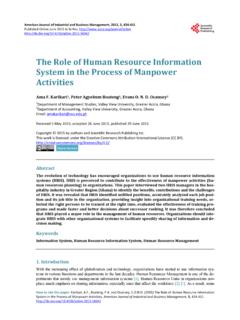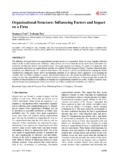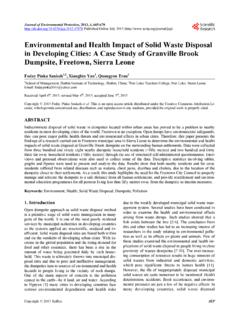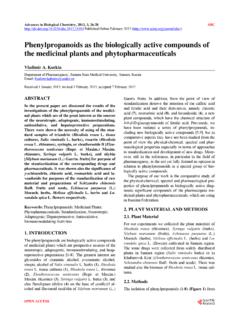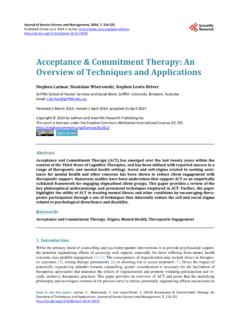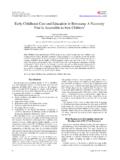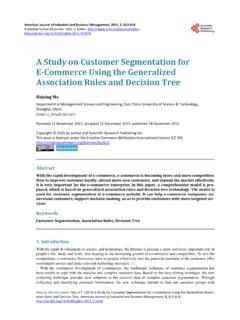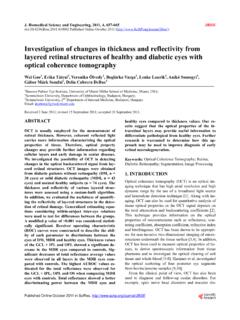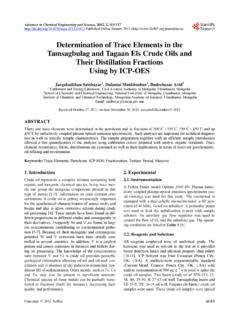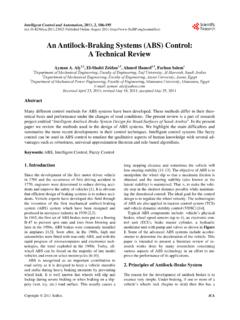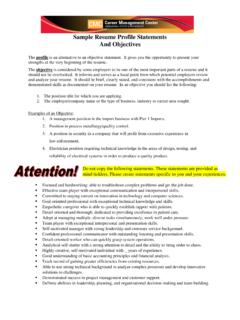Transcription of Framework of Construction Procedure Manuals for PMIS ...
1 Journal of Building Construction and Planning Research, 2013, 1, 45-53 Published Online June 2013 ( ) 45 Framework of Construction Procedure Manuals for PMIS Implementation Boong Yeol Ryoo Department of Construction Science, Texas A&M University, College Station, USA. Email: Received April 20th, 2013; revised May 22nd, 2013; accepted May 30th, 2013 Copyright 2013 Boong Yeol Ryoo. This is an open access article distributed under the Creative Commons Attribution License, which permits unrestricted use, distribution, and reproduction in any medium, provided the original work is properly cited. ABSTRACT Primarily project Procedure Manuals are intended to enforce company polices or procedures .
2 These Manuals are impor-tant pieces for successful project management in the Construction industry, because Construction projects are operated virtually. Even though subcontractors are responsible for field works, a general contractor is still responsible for pro- viding quality project management services for project owners. The more subcontractors involved, the harder it is to monitor and control them, due to the different management processes and procedures they use. More than 36 Procedure Manuals in the building and industrial Construction were reviewed to create process maps of various management ser- vices. According to surveys, larger contractors have a broader use of Procedure Manuals than smaller contractors.
3 The full-scale Manuals cover project administration, schedule, cost, contract administration, quality, or safety to home office operations. The small-scale Manuals cover from site mobilization, to startup and closeout. Small-scale operation manu- als are often used by medium to small contractors. This paper presents suggestions for integrated Procedure Manuals for Construction management firms based on studies of multiple Construction Procedure Manuals . A Framework for inte- grating Procedure Manuals is presented. The proposed Framework can be used to keep uniformity across management procedures and phases. In addition, it can be used to implement a project management system.
4 It can be used to forecast or evaluate management activities through replicability of the management responses. Keywords: Procedure Manuals ; Action Words; project management System 1. Introduction Background As part of their response to a request for proposal (RFP), a general contractor submits a set of project management Manuals to the owner as an element of the contract do- cuments. These are used to determine the level of man- agement competitiveness of the general contractor. The Manuals define necessary management tasks, processes, and procedures with included forms for those procedures . It is an essential piece for successful project management , because, while the management team and the subcon- tractors are connected through the project , each of them-has different management control.
5 In Construction , only a small number of general con- tractors actively implement project management proce- dures to describe how they manage building Construction projects. The majority tend to only use the documents and forms in the manual to track project issues, manage project budgets, and document issues for legal reasons. For those who do actively use these procedures they are given an advantage. Because most of them are in a spe- cialized limited number of Construction sectors, it helps them to develop a management plan, examine past per- formance or improve management performance and methods if they have a written Procedure manual [1].
6 The specialization of Construction companies and a lack of standardization in Construction project manage- ment hinder effective communication and documentation between contractors. The main issue in a relationship between contractors is neither of the parties wants to give up their management procedures , because both parties have built their entire systems on these procedures and there is difficulty in changing over to another system. The end result of this lack of standardization and mi- nority of companies that actively manage with proce- dures is that there are insufficient procedures for man- agement tasks and commitments.
7 This often leaves man- agers no choice but to rely on their past experience and individual knowledge to deal with managerial challenges. Copyright 2013 SciRes. JBCPR Framework of Construction Procedure Manuals for PMIS Implementation 46 In the short run this usually proves to be sufficient but this non-replicable style makes it difficult to study pro- ject performance to determine effective procedures . Also, a non-replicable style makes it difficult to have predict- ability for results, or incidents in a project . While there are several professional groups in the con- struction industry there is still a lack of standards that could be applied in this arena.
8 For example the Construc- tion management Association of America (CMAA) has released a list of standard services of Construction man- agement (CM) in seven management areas [2]. This is representative of the nature of the industry, constructors know what needs to be delivered; they just have a dif- ference of opinion on how to deliver the final product. Because of this, neither specific processes nor procedures are suggested. This lack of specificity leaves it to the individual general contractors to be responsible for cre- ating instructions for Construction managers. This re- sponsibility sometimes falls to the individual construc- tion manager, who is given a set of general rules and de- liverables and is left to come up with their own method of delivering within those rules.
9 To aid in Construction management , project manage- ment information systems (PMIS) have been adopted as a project controlling and monitoring tool. PMISs enable project managers to collect, distribute, measure, and pro- cess project data. Initially, large contractors had a ten- dency to use a custom designed PMIS for their manage- ment systems. Recently, however, they have started to adopt an off-the-shelf PMIS and adjusting their man- agement systems to the PMIS. Mainly this has been done due to the expense associated with a customized software system as opposed to one that is mass produced. Because the majority of the companies use non rep- licable styles, procedures have become unique to not only each company but to each manager in that company .
10 Thus, synchronizing an off-the-shelf PMIS and proce- dure Manuals are a challenge because this method of op- eration [3]. Purpose of the Study The purpose of this paper is to propose a Framework for integrated project management in the building industry. By studying processes and methods of existing Procedure Manuals , a base structure for project control and moni- toring procedures is proposed. Guaranteed Maximum Price CM (GMPCM) projects are an intended target because their management respon- sibility includes both project management and construc- tion operations. This gives them an opportunity to man- age, perform and report on the projects they are involved in.
